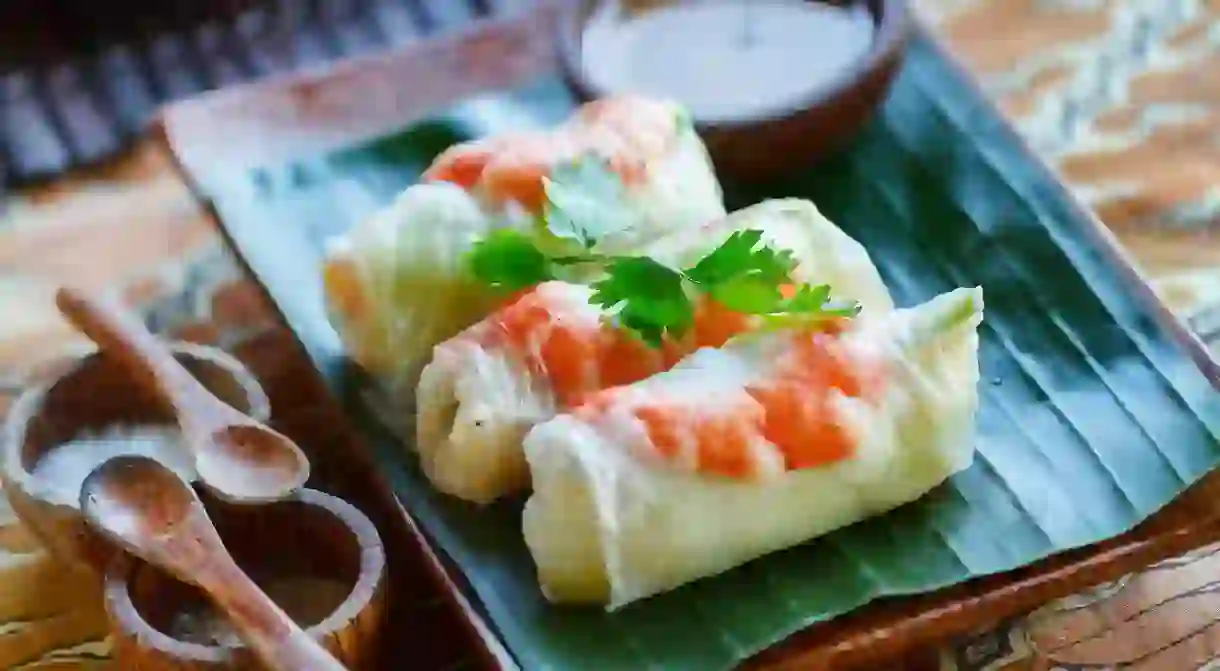The Healthiest Vietnamese Food

Healthy Vietnamese food is everywhere, whether you’re tucking into a bowl of pho (noodle soup) in Ho Chi Minh City or picking up a banh mi (filled baguette) – available pretty much anywhere in the world. Recipes are almost always prepared with fresh ingredients and most meals come with a huge side plate of vegetables and herbs. Here are some dishes from Vietnam that are not only healthy but also extremely yummy.
Goi cuon (fresh spring rolls)
Packed full of veggies and herbs, goi cuon are a delicious and healthy choice for an appetiser. Salad leaves, greens, vermicelli noodles and shrimp are wrapped in rice paper and come with a fish or peanut sauce for dipping. The fish sauce is light and thin and goes best with this meal; peanut sauce is made of peanut paste and coconut oil. Fresh spring rolls contain little oil and have almost zero fat, but they’re really tasty. Try not to mistake cha gio or nem ran (deep fried rolls) for fresh spring rolls, as those are cooked in oil.
Goi tom (shrimp salad)
There are generally few calories in Vietnamese food but goi tom is lighter than most. Essentially it’s the unwrapped version of goi cuon (fresh spring rolls). The shrimp salad is packed with an array of vegetables such as cabbage, cucumber, daikon and jalapeno peppers for a bit of heat. It is often ordered as a side and goes well with a bowl of sticky rice.
Pho (noodle soup)

A clear broth containing meat, noodles and herbs, pho (noodle soup) is the ideal dish for first thing in the morning – or at any time of the day. It is filling, full of fibre, antioxidants, minerals and vitamins and usually low in calories. You can always reduce the calories further by asking the waiter to add less meat.
Chao ga (Vietnamese congee/rice porridge)
In many Asian countries, this dish is fed to those who are sick as it is easy to eat and digest. The dish is made by cooking rice in water for a long time which, when absorbed, becomes a thick soup. Additional ingredients can be added, such as mushrooms, beans, peas, or even traditional medicinal herbs. Adding meat, such as shredded chicken, can add to the flavour.
Goi ngo sen (lotus root salad)

Rich in fibre and vitamins, lotus root salad helps keep your digestion system healthy. Lotus root is also known to have a wide range of health benefits, such as lowering blood pressure and reducing cholesterol. Combine it with carrots, pork, shrimp, herbs and seasoning and you will have yourself a nice meal.
Gao luc (brown rice)
High in magnesium and nutrients, brown rice is a healthy staple of Vietnamese food. It is often steamed and served with salad, stews, or mixed with peas and beans. You can find it in most grocery stores, vegetarian restaurants or Vietnamese restaurants.
Kho to (clay pot dishes)

In Vietnam, clay pot fish and clay pot pork are two of the most common dishes. Clay pots have the ability to absorb heat and cook food evenly. The clay also interacts with the acidity in the food and helps to neutralize the pH balance. The food also caramelises so you don’t have to use sugar.
Canh chua (Vietnamese sour soup)
This dish is indigenous to the Mekong Delta region of southern Vietnam. Pineapple, tomato and bean sprouts are added to a tamarind-flavoured broth. Tamarind gives the soup a sour taste. Fish and prawns are typically added. You can also add rice vermicelli and garnish with garlic and chopped spring onions.
Rau muong (stir fried water spinach)

This water spinach dish is stir fried with garlic and often paired with steamed fish and a bowl of brown rice. If it’s too salty for your liking, ask for it to be made with less fish sauce. Spinach and garlic are packed with vitamins, minerals, antioxidants and other nutrients.
Fresh Fruit

You will find fruit orchards all over Vietnam’s provinces, where you can take a tour, pluck the fruit off the trees and eat it right there. There are fruit stalls everywhere, too, selling oranges, mangosteen, dragon fruit, milk fruit, papaya and mangoes, often with a fruit dip made of powdered chilli, salt and sugar.













